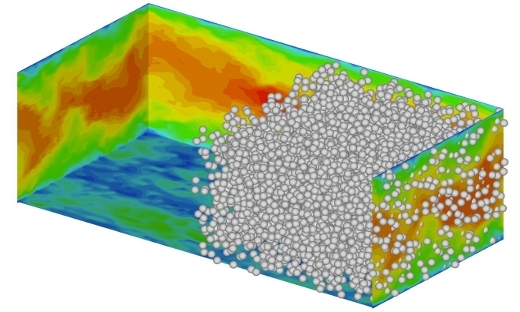FLOW Highlight: TRITOS: Transitions and Turbulence Of complex Suspensions

Visualization from our simulations of particle-laden channel flow. The solid phase is displayed only in one half of the domain. About 10000 particles are fully resolved in the simulations (800 grid points each). The simulation is the largest so far of wall-bounded turbulence in terms of particle number and domain size.
Investigating the mechanisms by which the system microstructure determines the macroscopic flow properties provides valuable insight into the nature of flowing suspensions, and also leads to new ways of modelling and controlling it.
Complex fluids are multi-scale by nature where the physics at the micro-scale affects the macroscopic behaviour of the flow and vice versa giving rise to surprising and spectacular phenomena as well as making this one of the most important practical problems remaining to be solved. Investigating the mechanisms by which the system microstructure determines the macroscopic flow properties and vice versa will not only give valuable insight into the nature of flowing suspensions, but will also lead to new ways of modelling and controlling it.
It is estimated that 10% of world energy consumption is due to the transport and handling of granular materials, of which particle suspensions are an important part. A deep understanding of the mechanisms underlying the flow of particle suspensions, the transition to turbulence and the turbulence characteristics are crucial for many important practical applications involving engineered complex fluids, such as pastes and paper pulp. Better prediction and control of the flow of suspensions will therefore have a huge impact.
Our aim is to develop the new generation of engineering CFD embedded with models for complex suspensions. The proposed project is based on highly accurate simulations of multiphase flow systems and state-of-the-art experiments. Such a holistic approach will enable us to understand the underlying mechanisms of instabilities and suspension turbulence and to develop accurate criteria for their prediction far in advance of what we could achieve with either approach separately.
References
F. Picano, W. P. Breugem, D. Mitra, L. Brandt. (2013) “Shear thickening in non-Brownian suspensions: an excluded volume effect.” Phys. Rev. Lett. 111, 098302, 2013.




